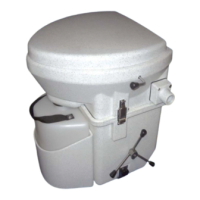
Do you have a question about the NATURE'S HEAD Self-Contained Composting Toilet and is the answer not in the manual?
| Brand | NATURE'S HEAD |
|---|---|
| Model | Self-Contained Composting Toilet |
| Category | Toilets |
| Language | English |
Lists items needed for installation and application-specific requirements (Tiny House, RV, Boat).
Details all components provided with the NATURE'S HEAD® composting toilet.
Discusses hose length options and floor construction considerations for mounting.
Explains the need for a 12V Power Transformer for 110V household power.
Details acceptable composting mediums like Sphagnum Peat Moss and Coconut Coir.
Specifies required clearance for servicing and how to remove the bowl.
Mentions the ability to switch handle and agitator sides.
Describes the unit's width with standard and spider handles.
Guides on choosing the optimal placement for the toilet.
Ensures adequate space for lid operation and bowl tilting for removal.
Specifies minimum clearance needed when mounting against a wall or bulkhead.
Advises on ensuring space for hose connection and agitator handle.
Suggests methods for servicing the toilet in very tight areas.
Details the process of mounting the toilet using L-brackets to the floor.
Guides on drilling pilot holes, checking behind walls, and using sealant.
Offers tips for correct bracket positioning and mounting, including for wet floors.
Explains the necessity of external venting for odor control and composting.
Lists common vent types and methods for through-wall or roof installation.
Describes the function of the included vent flange for connecting hoses.
Illustrates the airflow path for the toilet's venting system.
Explains how to attach standard and spider handles and reverse the agitator.
Describes swapping fan/filter housing for flexible hose installation.
Recommends using mesh fabric for insect barriers in vent openings.
Suggests using a PVC street elbow for 90-degree vent turns.
Highlights the suitability of the mushroom vent for marine and RV applications.
Details using vent flange and mushroom vent with boat pump-out fittings.
Provides guidance on hose clamping and confirming correct fan airflow.
Provides a step-by-step guide for installing the mushroom vent.
Covers locating exit points, drilling holes, and applying sealant.
Details replacing the base, securing it, and optionally using the vent flange.
Emphasizes fused circuits and specifies fuse ratings for 12V systems.
Explains powering the fan with a 110V adapter and its effect on fuse usage.
Advises consulting an electrician for complex wiring issues.
Directs users to website FAQs and email support for installation help.
Explains the waterless design, urine separation, and holding capacity.
Details how user numbers and usage affect solids bin emptying intervals.
States the urine bottle capacity and recommended emptying frequency.
Guides on adding sphagnum peat moss or coconut fiber to the toilet base.
Provides guidelines on medium dampness, storage, and non-use periods.
Highlights the importance of separating liquids and solids and educating guests.
Recommends seated use and explains trap door function for proper waste direction.
Discusses toilet paper and prohibits items like diapers and wipes.
Suggests using vinegar spray for cleaning and managing urine odors.
Explains the process of agitating solids with medium to promote composting.
Describes ideal compost appearance/odor and troubleshooting wetness or odor.
Discusses how health conditions affect compost and how to manage wetness.
Details the procedure for emptying the urine bottle and disposal options.
Explains how to remove the bowl and empty the solids container, including a bag method.
Advises against cleaning the solids container to preserve composting bacteria.
Recommends against prolonged storage of liquid waste to prevent odor.
Outlines procedures for composting solids in bins, dumpsters, or fertilizing plants.
Addresses challenges of full-time use, potential bacteria, and safety measures.
Presents using an extra base or storage bin for composting non-composted waste.
Provides basic cleaning advice using water, vinegar, or moistened paper towels.
Details intensive cleaning and strongly advises against harsh chemicals.
Focuses on cleaning filters yearly and ensuring correct fan reinstallation.
Details contacting customer service via email and phone, requesting specific info.
Informs about newsletters and provides instructions on how to subscribe.
Provides detailed steps for troubleshooting a non-working fan, including electrical checks.
Addresses wet compost issues, suggesting peat moss and odor troubleshooting.
Offers solutions for dry compost, recommending water and agitation.
Explains how temperature affects composting speed and dormancy.
Provides methods for controlling fruit flies and gnats using specific treatments.
Advises on troubleshooting a stiff agitator handle, suggesting coffee grounds.
Directs users to the website's FAQ section for additional tips and solutions.
Lists optional items like an extra liquids bottle for increased capacity.
Offers an extra base with lid for extended composting and a vented lid for transport.
Lists the AC adapter and various vent types (Mushroom, PVC) as available options.
States the 5-year warranty and the process for repairs or replacements.
Defines warranty coverage requirements, including purchase source and adherence to instructions.
Lists conditions and actions that void the warranty, such as misuse or improper installation.
Clarifies that this is the sole warranty and disclaims implied warranties.
Limits the company's responsibility for special, incidental, or consequential damages.
Instructs on how to file warranty claims, including required documentation and contact details.
